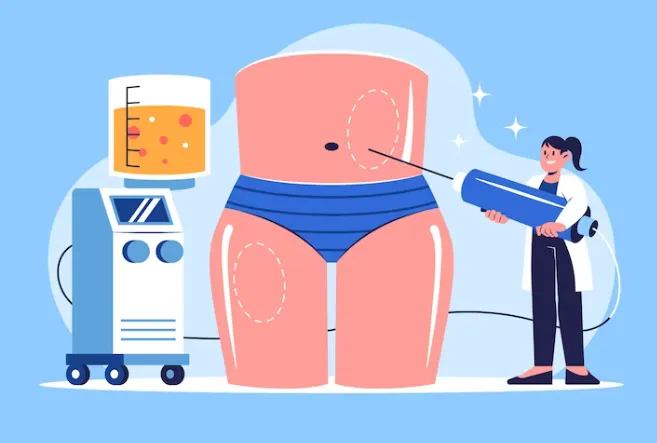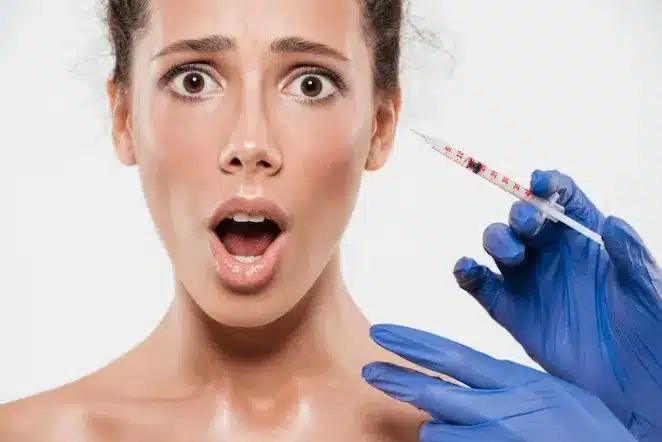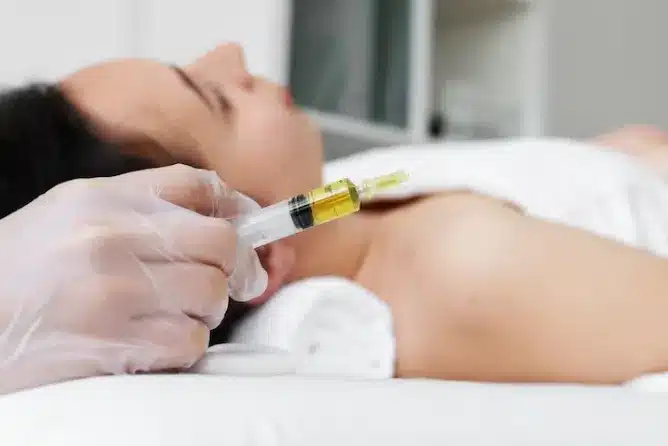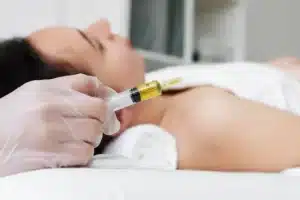Autologous fat grafting or Side Effects of Fat Transfer, employing liposuction for volume enhancement, offers a pathway to natural-looking results through the redistribution of one’s own fat. While this innovative technique has revolutionized cosmetic procedures, providing subtle and harmonious enhancements, it carries potential side effects. These range from temporary bruising and swelling at the donor and recipient sites to more complex issues like fat reabsorption, impacting the longevity and uniformity of the results.
Understanding Fat Transfer
Fat transfer involves three steps: harvesting fat cells, processing them, and reinjecting them into the desired area. The harvested fat is commonly taken from areas with excess fat deposits, such as the abdomen, thighs, or buttocks. This fat is then purified and prepared for injection, which can be performed in various body areas, including the face, breasts, buttocks, and hands.

Types of Fat Transfer and Associated Risks
Different fat transfer techniques include autologous fat transfer, micro-lipo injection, and structural fat grafting. Autologous fat transfer is the most commonly used method, where the patient’s fat is used for injection.
Micro-lipo injection involves injecting small amounts of fat into specific face areas. On the other hand, structural fat grafting involves transferring more significant amounts of fat to provide structural support and enhance volume.
Clinic contact number: +989371200167
Among these techniques, structural fat grafting is considered the most invasive and carries higher risks. The procedure involves injecting more significant volumes of fat, which increases the chances of complications such as fat necrosis (death of fat cells), uneven contouring, and risks associated with anesthesia.

20 Common Side Effects of Fat Transfer
1. Swelling: Swelling is a common side effects of fat transfer that can occur after a fat transfer procedure. It typically subsides within a few weeks but may sometimes last longer.
2. Bruising: Bruising is another common side effects of fat transfer that can occur due to the trauma caused by the harvesting and injection process.
3. Discomfort or pain: Mild discomfort or pain may be experienced at the injection sites or the area from where the fat was harvested.
4. Infection: Although rare, there is a risk of infection at the injection or harvesting sites.
5. Hematoma: A hematoma is a collection of blood that can occur under the skin, leading to localized swelling and bruising.
6. Scarring: In some cases, scarring may occur at the injection or harvesting sites.
7. Fat necrosis: Fat necrosis is the death of fat cells, which can lead to the formation of lumps or firmness in the treated area.
8. Asymmetry: Uneven fat distribution can result in asymmetry, where one side appears different.
9. Irregular contouring: Improper injection technique or fat absorption can lead to irregularities in the contour of the treated area.
10. Allergic reactions: Although rare, some patients may experience allergic reactions to medications or materials used during the procedure.
11. Seroma: A seroma is a pocket of fluid that can accumulate under the skin, causing swelling and discomfort.
12. Skin texture changes: another side effects of fat transfer is Some patients may notice changes in the texture of their skin, such as roughness or unevenness.
13. Pigmentation changes: In rare cases, pigmentation changes, such as hyperpigmentation or hypopigmentation, may occur in the treated area.
14. Numbness: Temporary numbness or altered sensation may be experienced at the injection or harvesting sites.
15. Cyst formation: In rare cases, cysts may form in the treated area, requiring medical intervention.
16. Absorption of fat: Not all transferred fat cells survive, and some may be absorbed by the body over time, resulting in decreased volume.
17. Fat embolism: Although extremely rare, there is a risk of fat entering the bloodstream and causing blockages in blood vessels.
18. Delayed healing: Some patients may experience delayed healing of the injection or harvesting sites, leading to prolonged recovery.
19. Persistent swelling: In rare cases, swelling may persist for an extended period, necessitating further medical intervention.
20. Unsatisfactory results: Despite the best efforts, there is a chance that the desired results may not be achieved, requiring additional procedures or adjustments.
Clinic contact number: +989371200167

Fat transfer surgery is safe. It’s important to work with a plastic surgeon who has extensive experience performing fat transfer because it requires a high degree of skill. Cleveland Clinic
5 Tips to Avoid Risks of Fat Transfer
- Choose a board-certified plastic surgeon with extensive experience in fat transfer procedures.
- Research the surgeon’s reputation and view before-and-after photos of previous patients.
- Communicate openly with your surgeon about your expectations and concerns.
- Follow all preoperative and postoperative instructions provided by your surgeon.
- Avoid smoking or using tobacco products, as they can impair healing and increase the risk of complications.
Fat injection therapy offers hope for reversing baldness
The innovative approach of using fat injections for hair loss treatment is gaining attention in the medical community.
A recent scientific review led by the Iran University of Medical Sciences (IUMS) has highlighted the potential benefits of fat injections for combating various types of alopecia, including scarring alopecia and common male pattern baldness.
Study significance.
“Alopecia may decrease patients’ quality of life and self-confidence by limiting their social life. Therefore, the main goal of the treatment is to limit or halt the progression of inflammation, scarring, and hair loss,” wrote the study authors.
“The promising effect of fat injection on hair regrowth, limited adverse effects, and subsiding inflammation can be proof of its efficacy and safety in treating alopecia.”
Fat transfer, also known as fat grafting or fat injection, is a procedure that involves removing excess fat from one area of the body, typically through liposuction, and transferring it to another area, such as the cheeks.
Key Contributors and Rising Popularity in Cosmetic Surgery
In the evolving field of cosmetic surgery, fat transfer has emerged as a key technique for natural-looking rejuvenation and volume enhancement, with significant contributions from esteemed institutions and practitioners. Prominent universities such as Harvard and Johns Hopkins have been at the forefront of research, pushing the boundaries of what is possible with autologous fat grafting. Among the luminaries, Dr. Sydney Coleman stands out for his pioneering work in refining the technique and promoting its wider acceptance within the medical community.
These efforts have been instrumental in establishing fat transfer as a safe, effective option for patients seeking cosmetic enhancements. On the clinical front, the Mayo Clinic has established itself as a leader in the application of fat transfer procedures, offering a wide range of treatments from facial rejuvenation to breast augmentation using the patient’s own fat. According to the American Society of Plastic Surgeons, there has been a notable increase in the popularity of fat grafting, with over 84,000 procedures performed in the last year alone, indicating a growing trust in this method among both patients and surgeons.
This trend is supported by advancements in technique and technology, spearheaded by companies like Allergan, which has been actively involved in developing products that complement fat transfer procedures, such as specialized liposuction equipment and bio-compatible materials that enhance the survival rate of grafted fat cells, further solidifying fat transfer’s position as a cornerstone of modern cosmetic and reconstructive surgery.

Risks of Fat Transfer
Fat transfer, also known as fat grafting or autologous fat transplantation, involves transferring fat from one part of the body to another to improve or augment the area. While it’s a widely used procedure for cosmetic and reconstructive purposes, like all medical procedures, it comes with its own set of risks and potential complications. Here are the key risks associated with fat transfer:
Infection
As with any surgical procedure, there’s a risk of infection at both the donor site (where the fat is taken from) and the recipient site (where the fat is placed).
Anesthesia Risks
Fat transfer procedures usually require local or general anesthesia, which carries risks such as allergic reactions, respiratory issues, and in rare cases, more serious complications.
Irregularities in Contour
There might be lumpiness or uneven texture at the donor or recipient site. The body may also absorb the transferred fat unevenly, leading to asymmetrical results.
Over- or Under-Correction
Achieving the desired aesthetic result can be challenging. There might be cases of over-correction, where too much fat is transferred, or under-correction, necessitating additional procedures.
Choosing a qualified, experienced surgeon and having a thorough consultation can help minimize these risks. It’s important for patients to discuss their medical history, concerns, and expectations openly with their healthcare provider to ensure the best possible outcomes.
Understanding the Cause
- Over-Correction: This often occurs when the surgeon injects more fat than necessary, anticipating that a certain percentage of the transferred fat cells will not survive. However, if a higher-than-expected percentage of fat survives, it can lead to an overly enhanced appearance.
- Under-Correction: This happens for the opposite reason; the surgeon may inject a conservative amount of fat, aiming to err on the side of caution. If the fat survival rate is lower than anticipated, or if the initial volume was insufficient for the desired change, the results may be underwhelming.
Prevention and Planning
Preventing over- or under-correction starts with meticulous planning:
- Detailed Consultation: A thorough discussion between the surgeon and the patient about expectations and achievable outcomes is crucial. Understanding the patient’s aesthetic goals can guide the surgeon in how much fat to harvest and inject.
- Accurate Volume Assessment: Surgeons often use imaging techniques or simulation software during the planning phase to estimate the volume of fat required to achieve the desired outcome accurately.
- Experience and Technique: Selecting a surgeon with extensive experience in fat transfer procedures is vital. Experienced surgeons are better at estimating the amount of fat that will survive the transfer process and are skilled in achieving a natural, symmetrical look.

Summary
The practice of autologous fat grafting, while highly effective for volume enhancement and facial rejuvenation, comes with a spectrum of potential side effects largely attributable to its two main components: liposuction and the reinjection of fat. Liposuction, the process of extracting fat from one part of the body, can lead to temporary bruising, swelling, and discomfort at the donor site, along with more rare risks such as infection or uneven skin contours. The fat survival rate, a crucial factor for the success of the graft, varies, with a portion of the transferred fat potentially being reabsorbed by the body, leading to under-correction that might necessitate additional procedures. Furthermore, there’s a risk of oil cyst formation or fat necrosis, where the transferred fat cells don’t integrate well, causing lumps or hardness in the treated area.
Beyond the technical aspects, body contouring and facial rejuvenation via fat transfer aim to harmonize and enhance one’s appearance, yet they must be approached with realistic expectations and an understanding of the recovery process. The outcomes depend on the technique of the surgeon, the patient’s health, and the body’s response to the transferred fat, highlighting the importance of selecting a skilled and experienced practitioner. Although complications are generally rare and often manageable, discussing potential side effects and thoroughly planning the procedure are essential steps in ensuring patient satisfaction and the best possible results from fat transfer surgery.
Clinic contact number: +989371200167
FAQs
1. What are the most common side effects immediately after a fat transfer procedure?
Immediately following a fat transfer procedure, the most common side effects include swelling, bruising, and redness at both the donor site (where the fat was harvested) and the recipient site (where the fat was injected). Pain and discomfort are also common but can usually be managed with prescribed or over-the-counter pain medication. These side effects are typically temporary and begin to improve within a few days to weeks after the procedure.
2. Can fat transfer result in uneven or lumpy textures?
Yes, one potential side effect of fat transfer is the development of uneven textures, such as lumps or bumps, at the injection site. This can occur if the fat does not settle smoothly or if there are variations in how the fat is absorbed back into the body. Skilled technique and proper post-operative care can minimize this risk, but in some cases, additional treatments or revisions may be necessary for correction.
3. Are there any long-term side effects associated with fat transfer?
While most side effects of fat transfer are temporary, there can be long-term complications or outcomes that some patients experience. These may include:
– Permanent changes in sensation (either increased sensitivity or numbness) at the donor or recipient sites.
– Fat necrosis, where transferred fat cells die, potentially leading to calcifications or oil cysts.
– Asymmetry or dissatisfaction with aesthetic outcomes, sometimes requiring additional corrective procedures.
4. Is there a risk of infection with fat transfer?
As with any surgical procedure, there is a risk of infection with fat transfer. However, the risk is relatively low when the procedure is performed in a sterile environment by a qualified and experienced surgeon. Symptoms of infection may include excessive redness, warmth, swelling, or drainage at the surgical site, and fever. If an infection is suspected, it is important to contact the surgeon immediately for assessment and treatment.
5. How does the body react to the transferred fat? Is there a risk of rejection?
One of the benefits of using your own fat for augmentation or enhancement is that there is no risk of allergic reaction or rejection, as can be the case with synthetic materials or implants. The body recognizes the fat as its own tissue. However, not all of the transferred fat survives the transplant process; some of it is reabsorbed by the body. The amount of fat that ultimately survives and remains stable varies from person to person but is typically between 50% to 70%. Your surgeon may overcorrect, injecting more fat than needed, to account for this absorption.
When considering fat transfer, it’s important to discuss all potential side effects and risks with a board-certified plastic surgeon. Understanding the procedure, recovery expectations, and potential complications can help ensure the best possible outcome.
Fat Transfer: Surgeries, Results, Risks & What to Expect (clevelandclinic.org)
Fat injection therapy offers hope for reversing baldness • Earth.com



